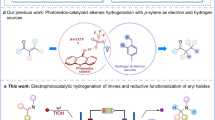Abstract
It has been shown by cyclic voltammetry in THF within the −90 to 40 °C temperature range that fluorenyl (η5-9-R-C13H8)Mn(CO)3 complexes (R=But (3) and Ph (4)) undergo two-electron reduction to form allyl type [(η3-9-R-C13H8)Mn(CO)3]2− dianions as final products. At low temperatures complexes3 and4 are reduced in two one-electron steps according to the EEC-scheme. The first step is reversible and corresponds to the formation of 19ē-radical anions 3−. and 4−.. TheE 0 values for redox pairs3 0/−. and4 0/−. are −1.88 and −1.73 V, respectively. The further reduction of radical anions3 −. and4 −. at more negative potentials is accompanied by fast η5 → η3 haptocoordination of the fluorenyl ligand to form 18ē-dianions [(η3-9-R-C13H8)Mn(CO)3]2−. These dianions obtained by the reduction of complexes3 and4 by the radical anion of pyrene are stable at −80 °C and are characterized by their IR spectra. At room temperature the η5 ⇔ η3 hapticity change is a fast and reversible process occurring at the step of 19ē-radical anions3 −. and4 −. and leading to the electron deficient 17ē-species [(η3-9-R-C13H8)Mn(CO)3]−., which are reduced easier than the initial complexes. As a result, complexes3 and4 are reduced to the corresponding dianions [(η3-9-R-C13H8)Mn(CO)3]2− at room temperature in one reversible two-electron step according to the ECE-scheme. Reactivities of 19e−-species of the isomeric η5- and η6-fluorenylmanganesetricarbonyl complexes are compared.
Similar content being viewed by others
References
D. Astruc,Chem. Revs., 1988,88, 1189.
Organometallic Radical Processes, Ed. W. C. Trogler, Elsevier, Amsterdam, 1990.
V. V. Strelets,Coord. Chem. Rev., 1992,114, 1.
S. V. Kukharenko, L. N. Novikova, V. V. Strelets, N. A. Ustynyuk, and A. I. Yarmolenko,Izv. Akad. Nauk, Ser. Khim., 1994, 1805 [Russ. Chem. Bull., 1994, 1710 (Engl. Transl.)].
A. J. Bard and L. R. Faulkner,Electrochemical Methods, John Wiley & Sons, 1980.
S. Lee and N. J. Cooper,J. Am. Chem. Soc., 1991,113, 716.
C. K. Mann and K. K. Barnes,Electrochemical Reactions in Nonaqueous Systems, Marcel Dekker, Inc., N. Y., 1970.
W. J. Bowyer and W. E. Geiger,J. Am. Chem. Soc., 1985,107, 5657.
W. J. Bowyer, J. W. Merkert, W. E. Geiger, and A. L. Rheingold,Organometallics, 1989,8, 191.
G. A. Miller, M. J. Therien, and W. C. Trogler,J. Organomet. Chem., 1990,383, 271.
S. N. Milligan and R. D. Rieke,Organometallics, 1983,2, 171.
R. D. Rieke, W. P. Henry, and J. S. Arney,Inorg. Chem, 1987,26, 420.
A. J. Hart-Davis, C. White, and R. J. Mawby,Inorg. Chim. Acta, 1970,4, 441; M. E. Rerek, L.-N. Ji, and F. Basolo,J. Chem. Soc., Chem. Commun., 1983, 1208.
S. V. Kukharenko, V. V. Strelets, N. A. Ustynyuk, L. N. Novikova, M. G. Peterleitner, and L. I. Denisovich,Metalloorg. Khim., 1991,4, 299 [Organomet. Chem. USSR, 1991,4 (Engl. Transl.)].
L. N. Novikova, B. A. Mazurchik, N. A. Ystynyuk, S. V. Kukharenko, and V. V. Strelets,Izv. Akad. Nauk, Ser. Khim., 1994, 319 [Russ. Chem. Bull., 1994, 136 (Engl. Transl.)].
S. V. Kukharenko, L. N. Novikova, V. V. Strelets, and N. A. Ustynyuk,Izv. Akad. Nauk, Ser. Khim., 1994, 48 [Russ. Chem. Bull., 1994, 41 (Engl. Transl.)].
S. V. Kukharenko, G. L. Soloveichik, and V. V. Strelets,Izv. Akad. Nauk SSSR, Ser. Khim., 1986, 1020 [Bull. Acad. Sci. USSR, Div. Chem. Sci., 1986, 926 (Engl. Transl.)].
F. Ullmann and R. Wurstemberger,Ber. Dtsch. Chem. Ges., 1904,37, 73.
F. A. L. Anet and P. M. G. Bavin,Can. J. Chem., 1956,34, 991; P. M. G. Bavin,Anal. Chem., 1960,32, 554.
P. M. Treichel and J. W. Johnson,Inorg. Chem., 1977,16, 749.
R. B. King and A. Efraty,J. Organomet. Chem., 1970,23, 527.
Author information
Authors and Affiliations
Additional information
Translated fromIzvestiya Akademii Nauk. Seriya Khimicheskaya, No. 7, pp. 1347–1353, July, 1995.
The work was financially supported by the Russian Foundation for Basic Research (Project No. 93-03-05209) and the International Science Foundation (Grant No. REV 000).
Rights and permissions
About this article
Cite this article
Yarmolenko, A.I., Kukharenko, S.V., Novikova, L.N. et al. Redox-induced η5 ⇔ η3 haptotropy of the fluorenyl ligand in 9-substituted η5-fluorenylmanganesetricarbonyl complexes. Russ Chem Bull 44, 1300–1305 (1995). https://doi.org/10.1007/BF00700908
Received:
Issue Date:
DOI: https://doi.org/10.1007/BF00700908




